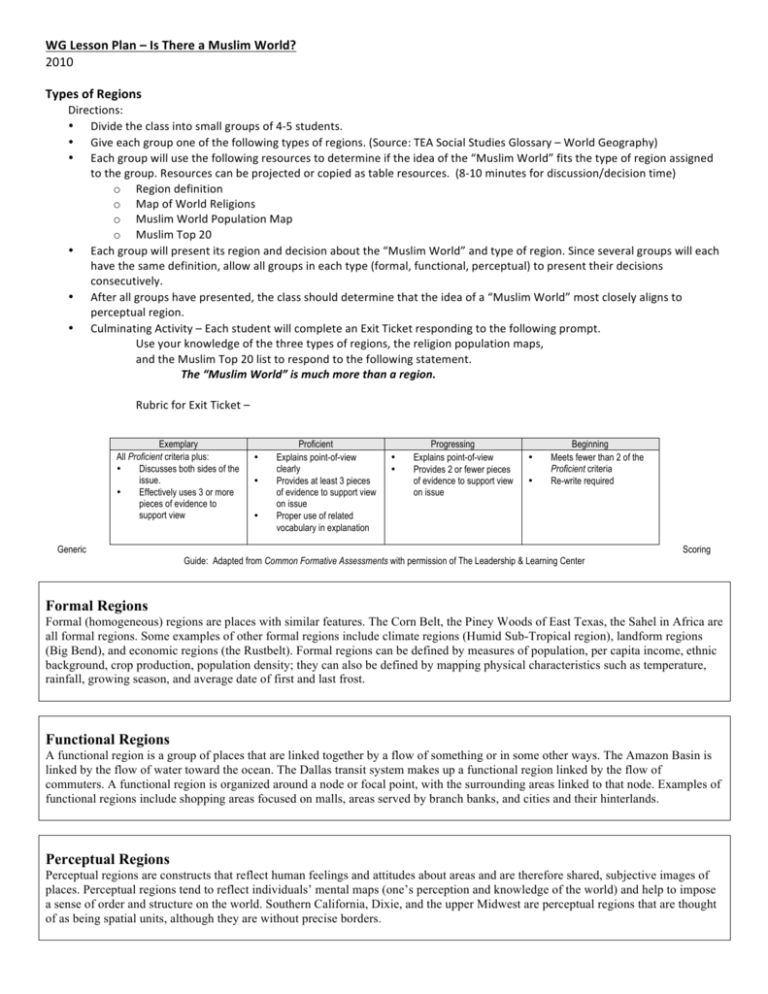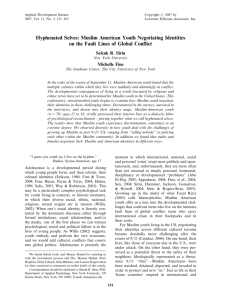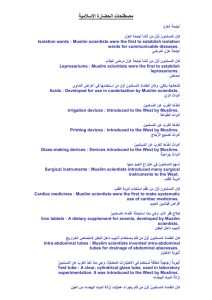Types of Regions
advertisement

WG Lesson Plan – Is There a Muslim World? 2010 Types of Regions Directions: • Divide the class into small groups of 4-­‐5 students. • Give each group one of the following types of regions. (Source: TEA Social Studies Glossary – World Geography) • Each group will use the following resources to determine if the idea of the “Muslim World” fits the type of region assigned to the group. Resources can be projected or copied as table resources. (8-­‐10 minutes for discussion/decision time) o Region definition o Map of World Religions o Muslim World Population Map o Muslim Top 20 • Each group will present its region and decision about the “Muslim World” and type of region. Since several groups will each have the same definition, allow all groups in each type (formal, functional, perceptual) to present their decisions consecutively. • After all groups have presented, the class should determine that the idea of a “Muslim World” most closely aligns to perceptual region. • Culminating Activity – Each student will complete an Exit Ticket responding to the following prompt. Use your knowledge of the three types of regions, the religion population maps, and the Muslim Top 20 list to respond to the following statement. The “Muslim World” is much more than a region. Rubric for Exit Ticket – Exemplary All Proficient criteria plus: • Discusses both sides of the issue. • Effectively uses 3 or more pieces of evidence to support view • • • Proficient Explains point-of-view clearly Provides at least 3 pieces of evidence to support view on issue Proper use of related vocabulary in explanation • • Progressing Explains point-of-view Provides 2 or fewer pieces of evidence to support view on issue • • Beginning Meets fewer than 2 of the Proficient criteria Re-write required Generic Scoring Guide: Adapted from Common Formative Assessments with permission of The Leadership & Learning Center Formal Regions Formal (homogeneous) regions are places with similar features. The Corn Belt, the Piney Woods of East Texas, the Sahel in Africa are all formal regions. Some examples of other formal regions include climate regions (Humid Sub-Tropical region), landform regions (Big Bend), and economic regions (the Rustbelt). Formal regions can be defined by measures of population, per capita income, ethnic background, crop production, population density; they can also be defined by mapping physical characteristics such as temperature, rainfall, growing season, and average date of first and last frost. Functional Regions A functional region is a group of places that are linked together by a flow of something or in some other ways. The Amazon Basin is linked by the flow of water toward the ocean. The Dallas transit system makes up a functional region linked by the flow of commuters. A functional region is organized around a node or focal point, with the surrounding areas linked to that node. Examples of functional regions include shopping areas focused on malls, areas served by branch banks, and cities and their hinterlands. Perceptual Regions Perceptual regions are constructs that reflect human feelings and attitudes about areas and are therefore shared, subjective images of places. Perceptual regions tend to reflect individuals’ mental maps (one’s perception and knowledge of the world) and help to impose a sense of order and structure on the world. Southern California, Dixie, and the upper Midwest are perceptual regions that are thought of as being spatial units, although they are without precise borders.










